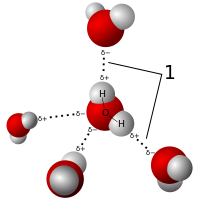
Photo from wikipedia
The gas phase mechanism for peptide bond formation between two double amino acid (DAA) molecules ((NH2)2C(COOH)2) is investigated in the absence of any catalysts. Two different paths, concerted and stepwise,… Click to show full abstract
The gas phase mechanism for peptide bond formation between two double amino acid (DAA) molecules ((NH2)2C(COOH)2) is investigated in the absence of any catalysts. Two different paths, concerted and stepwise, each leading to both cis and trans DAA-DAA dipeptide products (four mechanisms total) are examined on the basis of theoretical calculations carried out at the CCSD(T)/aug-cc-pVDZ//MP2/aug-cc-pVDZ level. The investigation indicates that the concerted mechanism leading to the trans configuration of the peptide bond in the DAA-DAA dipeptide product is thermodynamically favored by about 5 kcal mol−1 and requires slightly less energy than the remaining pathways considered. Moreover, the peptide bond formation process between two DAA molecules in the gas phase resembles the analogous reactions between two natural amino acids.
Journal Title: International Journal of Quantum Chemistry
Year Published: 2017
Link to full text (if available)
Share on Social Media: Sign Up to like & get
recommendations!